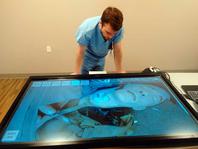ISAT Lab tests AR project in battlefield simulation
Under the guidance of Juan Wachs, the James A. and Sharon M. Tompkins Rising Star Associate Professor of Industrial Engineering, PhD student Edgar Rojas Muñoz and other graduate students used ISAT's System for Telementoring with Augmented Reality (STAR) to help direct medical corpsmen to perform a remote medical procedure. The experiment simulated a battlefield emergency surgery, and expert Indianapolis surgeons worked with Naval Medical Center Portsmouth (NMCP) medical corpsmen in Virginia to perform a cricothyroidotomy (opening an emergency airway) procedure on a "patient simulator" (mannequin).
The goal of the experiment was to assess the latest version of STAR based on an augmented reality head-mounted display, evaluating STAR in an "austere" (battlefield) simulation setting. The validation was done in an NMCP facility which has simulated battlefield conditions such as background smoke and sounds of gunshots and explosions. The experiment compared STAR to another telementoring approach, audio-only communication. Twenty NMCP corpsmen (mentees) were remotely guided by the remote team expert surgeons (mentors) in Indianapolis to complete a cricothyroidotomy procedure on a patient simulator. At the same time, on-site NMCP personnel evaluated the participants in terms of completion time, performance, and safety.
The experiment took an entire day to complete. Each participant did two approximately five-minute repetitions of the cricothyroidotomy procedure, one per telementoring condition. The two telementoring conditions were: 1) STAR, and 2) audio-only communication. Muñoz directed the experiment in Indianapolis, while Sanchez and Lin directed the Virginia site.
Results showed that when using STAR, participants obtained significantly higher procedural scores than with audio-only communication, did not take appreciably longer to complete the procedure, and performed more safely overall.
The Indianapolis Team included four people in two groups:
- Purdue Team: 1 IE graduate student (Edgar Rojas) and 1 IE Faculty (Dr. Juan Wachs)
- IU School of Medicine Faculty Team at Sydney and Lois Eskenazi Hospital: 1 fellow (Dr. Pat Murphy) and 1 Faculty (Dr. Ben Zarzaur)
The Virginia team included of seven people in two groups:
- Purdue Team: 2 IE graduate students (Natalia Sanchez and Juan Antonio Barragan) and 1 CS graduate student (Chengyuan Lin) + 1 CS faculty (Dr. Voicu Popescu).
- NMCP Team: 1 Surgery Resident (Clare Griffis) + 1 Faculty Member (Dr. Thomas Douglas III CDR), and 1 contractor (Mr. Michael Mitchell)
Although this experiment's purpose was not to compare a controlled setting (like at a university) with a battlefield situation, Muñoz and his team did see significant differences. "It was very interesting to see the way in which the military managed things - everything was on time, not a single detail was out of place," said Muñoz. "Coordination was key to performing this experiment, with the team geographically divided."
"In addition, several dry runs were performed to ensure the experiment's success, which I would recommend to anyone wanting to perform a user study," he continued. "Dry runs can be time-consuming but will help to detect flaws in the experimental designs."
This was the last experiment in the original grant proposal, titled "See-What-I-do: Increasing Mentor and Trainee Sense of Co-Presence in Trauma Surgery with the STAR Platform".
"The project is on its last stages," continued Munoz. "Most of the work now is focused on dissemination of the technology and development of extra features for the system. For example, we are developing a feature to capture the expert surgeons' arms, and transfer a virtual version of them that can be visualized by the mentees. This can be useful in scenarios in which the mentors want to point a specific location in the patient's body or demonstrate the proper use of a surgical instrument."
Source: Edgar Rojas Muñoz, emuoz@purdue.edu
Writer: DeEtte Starr, starrd@purdue.edu


